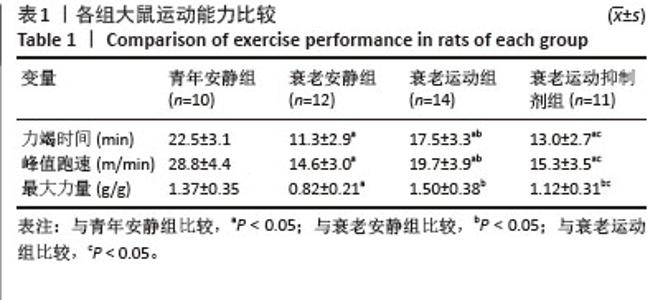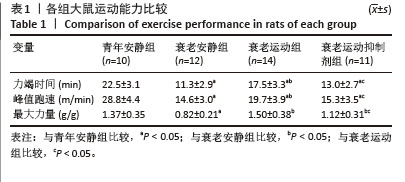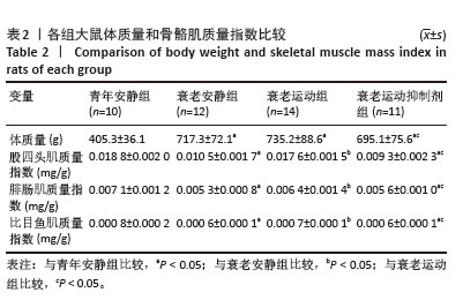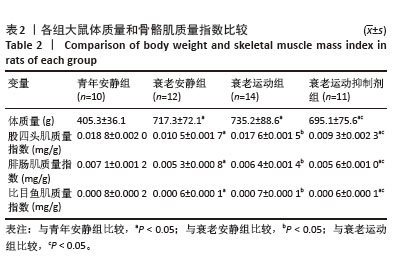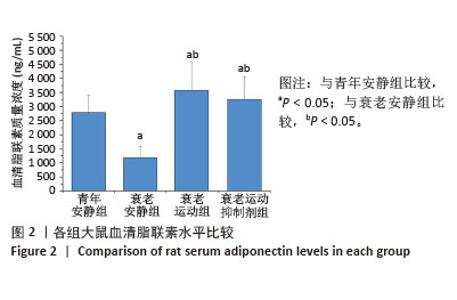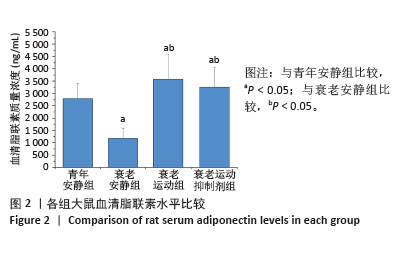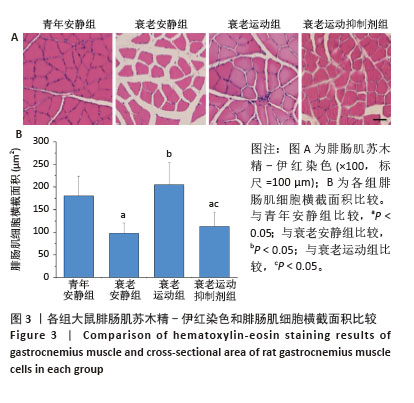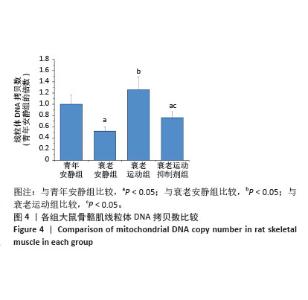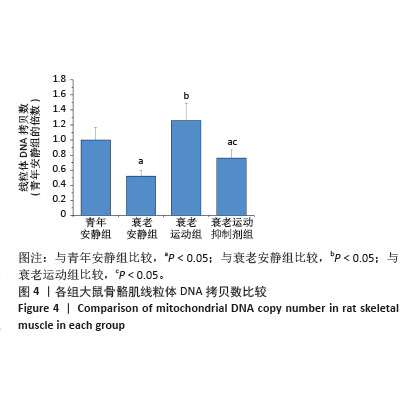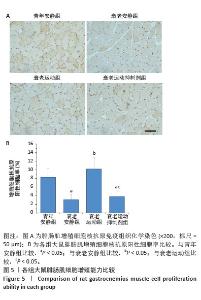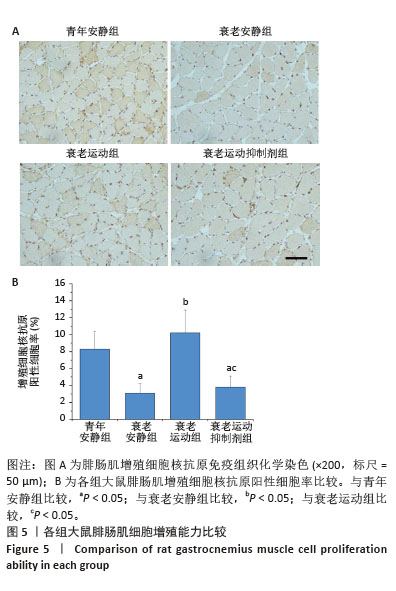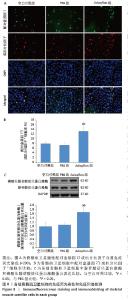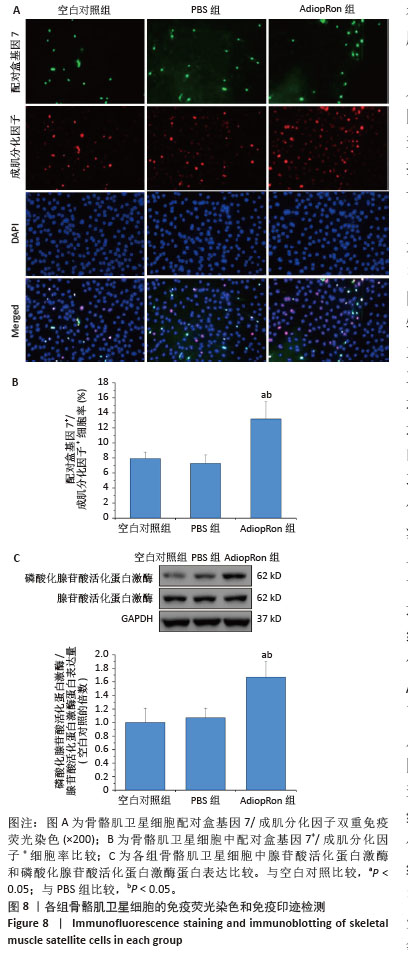Chinese Journal of Tissue Engineering Research ›› 2026, Vol. 30 ›› Issue (7): 1736-1746.doi: 10.12307/2026.061
Previous Articles Next Articles
Resistance exercise activates skeletal muscle satellite cells in aged rats: role of adiponectin receptor 1 pathway
Pan Dong1, Yang Jialing1, Tian Wei2, Wang Dongji2, Zhu Zheng3, Ma Wenchao3, Liu Na3, Fu Changxi3
- 1School of Physical Education, Lianyungang Normal College, Lianyungang 222006, Jiangsu Province, China; 2Department of Endocrinology, Lianyungang Hospital of Traditional Chinese Medicine, Lianyungang 222100, Jiangsu Province, China; 3Department of Physical Education, Xuzhou University of Technology, Xuzhou 221008, Jiangsu Province, China
-
Received:2025-01-25Revised:2025-05-13Accepted:2025-06-20Online:2026-03-08Published:2025-08-19 -
Contact:Fu Changxi, PhD, Associate professor, Department of Physical Education, Xuzhou University of Technology, Xuzhou 221008, Jiangsu Province, China -
About author:Pan Dong, PhD, Lecturer, School of Physical Education, Lianyungang Normal College, Lianyungang 222006, Jiangsu Province, China -
Supported by:Jiangsu Province Industry-University-Research Cooperation Project, No. BY20221256 (to FCX); Jiangsu Province Social Science Fund Project, No. 22TYD001 (to FCX)
CLC Number:
Cite this article
Pan Dong, Yang Jialing, Tian Wei, Wang Dongji, Zhu Zheng, Ma Wenchao, Liu Na, Fu Changxi. Resistance exercise activates skeletal muscle satellite cells in aged rats: role of adiponectin receptor 1 pathway[J]. Chinese Journal of Tissue Engineering Research, 2026, 30(7): 1736-1746.
share this article
Add to citation manager EndNote|Reference Manager|ProCite|BibTeX|RefWorks
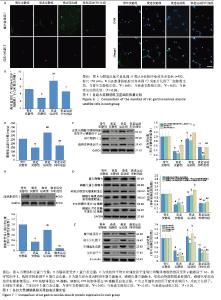
2.8 各组大鼠骨骼肌卫星细胞数量比较 免疫荧光染色显示,配对盒基因7阳性细胞呈绿色荧光、成肌分化因子阳性细胞呈红色荧光,DAPI阳性呈蓝色荧光,见图6A。与青年安静组比较,衰老安静组配对盒基因7阳性/成肌分化因子阳性细胞率降低(P < 0.05)。与衰老安静组比较,衰老运动组配对盒基因7阳性/成肌分化因子阳性细胞率升高(P < 0.05)。与衰老运动组比较,衰老运动抑制剂组配对盒基因7阳性/成肌分化因子阳性细胞率降低(P < 0.05),见图6B。 2.9 各组大鼠骨骼肌蛋白表达量比较 与青年安静组比较,衰老安静组总蛋白含量以及脂联素受体1、过氧化物酶体增殖物激活受体γ辅激活子1α、核呼吸因子1、线粒体转录因子A、磷酸化蛋白激酶B/蛋白激酶B、磷酸化哺乳动物雷帕霉素靶蛋白/哺乳动物雷帕霉素靶蛋白、磷酸化P70核糖体蛋白S6激酶/P70核糖体蛋白S6激酶、配对盒基因7、成肌分化因子、肌细胞生成素、生肌因子5蛋白表达量下调(P < 0.05)。与衰老安静组比较,衰老运动组总蛋白含量以及脂联素受体1、过氧化物酶体增殖物激活受体γ辅激活子1α、核呼吸因子1、线粒体转录因子A、磷酸化蛋白激酶B/蛋白激酶B、磷酸化哺乳动物雷帕霉素靶蛋白/哺乳动物雷帕霉素靶蛋白、磷酸化P70核糖体蛋白S6激酶/P70核糖体蛋白S6激酶、配对盒基因7、成肌分化因子、肌细胞生成素、生肌因子5蛋白表达量上调(P < 0.05)。与衰老运动组比较,衰老运动抑制剂组总蛋白含量以及脂联素受体1、过氧化物酶体增殖物激活受体γ辅激活子1α、核呼吸因子1、线粒体转录因子A、磷酸化蛋白激酶B/蛋白激酶B、磷酸化哺乳动物雷帕霉素靶蛋白/哺乳动物雷帕霉素靶蛋白、磷酸化P70核糖体蛋白S6激酶/P70核糖体蛋白S6激酶、配对盒基因7、成肌分化因子、肌细胞生成素、生肌因子5蛋白表达量下调(P < 0.05),见图7。 "
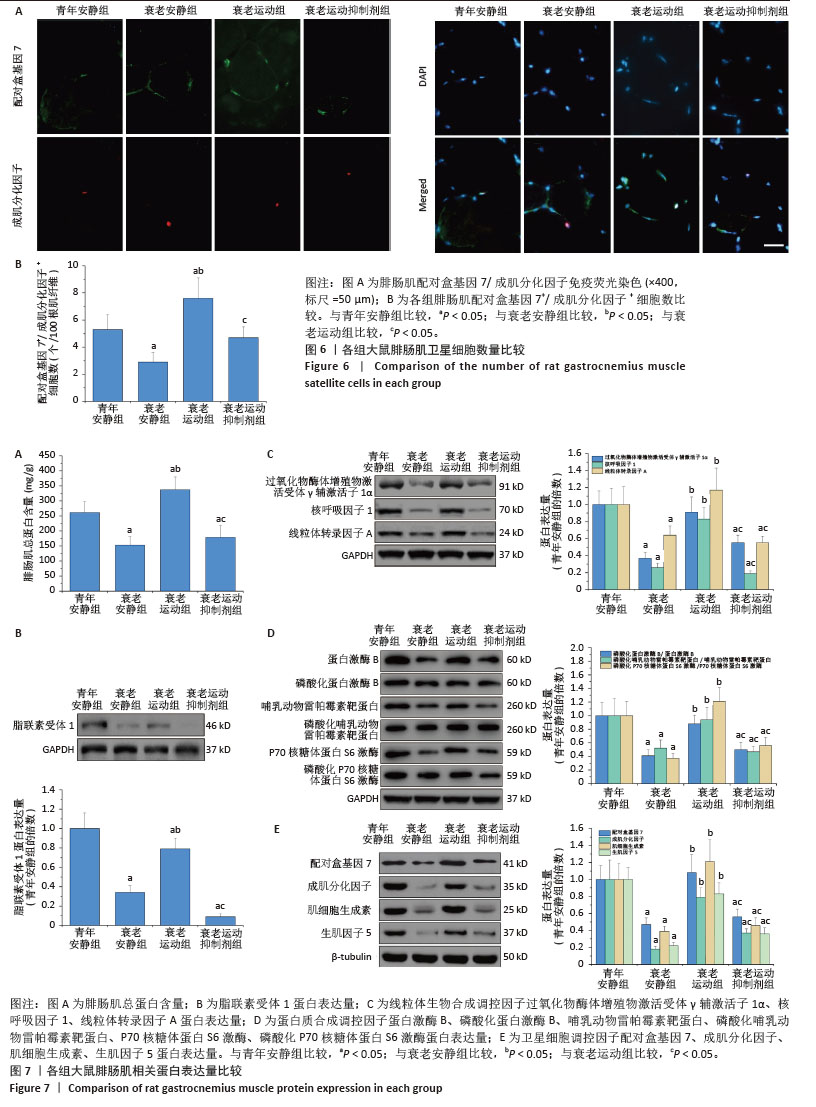
| [1] LIM JY, FRONTERA WR. Single skeletal muscle fiber mechanical properties: A muscle quality biomarker of human aging. Eur J Appl Physiol. 2022;122(6):1383-1395. [2] NARUSE M, TRAPPE S, TRAPPE TA. Human skeletal muscle-specific atrophy with aging: a comprehensive review. J Appl Physiol (1985). 2023;134(4):900-914. [3] KANG YK, MIN B, EOM J, et al. Different phases of aging in mouse old skeletal muscle. Aging (Albany NY). 2022;14(1):143-160. [4] MARZUCA-NASSR GN, SANMARTíN-CALíSTO Y, GUERRA-VEGA P, et al. Skeletal muscle aging atrophy: assessment and exercise-based treatment. Adv Exp Med Biol. 2020;1260:123-158. [5] GUILHOT C, CATENACCI M, LOFARO S, et al. The satellite cell in skeletal muscle: A story of heterogeneity. Curr Top Dev Biol. 2024;158: 15-51. [6] BACHMAN JF, CHAKKALAKAL JV. Satellite cells in the growth and maintenance of muscle. Curr Top Dev Biol. 2024;158:1-14. [7] SOUSA-VICTOR P, GARCÍA-PRAT L, MUÑOZ-CÁNOVES P. Control of satellite cell function in muscle regeneration and its disruption in ageing. Nat Rev Mol Cell Biol. 2022;23(3):204-226. [8] KIM YA, KIM YS, OH SL, et al. Autophagic response to exercise training in skeletal muscle with age. J Physiol Biochem. 2013;69(4): 697-705. [9] BETIK AC, THOMAS MM, WRIGHT KJ, et al. Exercise training from late middle age until senescence does not attenuate the declines in skeletal muscle aerobic function. Am J Physiol Regul Integr Comp Physiol. 2009;297(3):R744-755. [10] CURRIER BS, MCLEOD JC, BANFIELD L, et al. Resistance training prescription for muscle strength and hypertrophy in healthy adults: A systematic review and bayesian network meta-analysis. Br J Sports Med. 2023;57(18):1211-1220. [11] 付常喜,何瑞波,马刚,等.不同运动模式影响心肌梗死致心力衰竭大鼠骨骼肌重塑的机制[J].中国组织工程研究,2025,29(2): 221-230. [12] LI Y, ONODERA T, SCHERER PE. Adiponectin. Trends Endocrinol Metab. 2024;35(7):674-675. [13] LI P, ZHANG S, SONG H, et al. Naringin promotes skeletal muscle fiber remodeling by the Adipor1-APPL1-AMPK signaling pathway. J Agric Food Chem. 2021;69(40):11890-11899. [14] LI N, ZHAO S, ZHANG Z, et al. Adiponectin preserves metabolic fitness during aging. Elife. 2021;10:e65108. [15] CHEN MB, MCAINCH AJ, MACAULAY SL, et al. Impaired activation of amp-kinase and fatty acid oxidation by globular adiponectin in cultured human skeletal muscle of obese type 2 diabetics. J Clin Endocrinol Metab. 2005;90(6):3665-3672. [16] MURASE T, HARAMIZU S, OTA N, et al. Suppression of the aging-associated decline in physical performance by a combination of resveratrol intake and habitual exercise in senescence-accelerated mice. Biogerontology. 2009;10(4):423-434. [17] LAKHDAR N, DENGUEZLI M, ZAOUALI M, et al. Six months training alone or combined with diet alters HOMA-AD, HOMA-IR and plasma and adipose tissue adiponectin in obese women. Neuro Endocrinol Lett. 2014;35(5):373-379. [18] 朱政,付常喜,马文超,等.有氧运动调控自发性高血压模型大鼠心脏重塑的机制[J].中国组织工程研究,2022,26(14):2231-2237. [19] DE SOUSA NETO IV, DURIGAN J, CARREIRO DE FARIAS JUNIOR G, et al. Resistance training modulates the matrix metalloproteinase-2 activity in different trabecular bones in aged rats. Clin Interv Aging. 2021;16:71-81. [20] IKEDO A, KIDO K, ATO S, et al. The effects of resistance training on bone mineral density and bone quality in type 2 diabetic rats. Physiol Rep. 2019;7(6):e14046. [21] TANG L, ZHAO T, KANG Y, et al. MSTN is an important myokine for weight-bearing training to attenuate bone loss in ovariectomized rats. J Physiol Biochem. 2022;78(1):61-72. [22] KELTY TJ, MAO X, KERR NR, et al. Resistance-exercise training attenuates LPS-induced astrocyte remodeling and neuroinflammatory cytokine expression in female wistar rats. J Appl Physiol (1985). 2022; 132(2):317-326. [23] STARON RS, HAGERMAN FC, HIKIDA RS, et al. Fiber type composition of the vastus lateralis muscle of young men and women. J Histochem Cytochem. 2000;48(5):623-629. [24] TANG G, DU Y, GUAN H, et al. Butyrate ameliorates skeletal muscle atrophy in diabetic nephropathy by enhancing gut barrier function and FFA2-mediated PI3K/Akt/mTOR signals. Br J Pharmacol. 2022; 179(1):159-178. [25] BASU U, BOSTWICK AM, DAS K, et al. Structure, mechanism, and regulation of mitochondrial DNA transcription initiation. J Biol Chem. 2020;295(52):18406-18425. [26] HALLING JF, PILEGAARD H. PGC-1α-mediated regulation of mitochondrial function and physiological implications. Appl Physiol Nutr Metab. 2020;45(9):927-936. [27] LIM C, NUNES EA, CURRIER BS, et al. An evidence-based narrative review of mechanisms of resistance exercise-induced human skeletal muscle hypertrophy. Med Sci Sports Exerc. 2022;54(9):1546-1559. [28] HSU WB, LIN SJ, HUNG JS, et al. Effect of resistance training on satellite cells in old mice - a transcriptome study : Implications for sarcopenia. Bone Joint Res. 2022;11(2):121-133. [29] GALLAGHER H, HENDRICKSE PW, PEREIRA MG, et al. Skeletal muscle atrophy, regeneration, and dysfunction in heart failure: Impact of exercise training. J Sport Health Sci. 2023;12(5):557-567. [30] FUKADA SI, NAKAMURA A. Exercise/resistance training and muscle stem cells. Endocrinol Metab (Seoul). 2021;36(4):737-744. [31] HICKS MR, SALEH KK, CLOCK B, et al. Regenerating human skeletal muscle forms an emerging niche in vivo to support PAX7 cells. Nat Cell Biol. 2023;25(12):1758-1773. [32] SHEPHERD DW, NORRIS JM, SIMPSON BS, et al. Effects of photobiomodulation therapy on regulation of myogenic regulatory factor mRNA expression in vivo: A systematic review. J Biophotonics. 2022;15(2):e202100219. [33] KONG L, FANG Y, DU M, et al. Gαi2 regulates the adult myogenesis of masticatory muscle satellite cells. J Cell Mol Med. 2023;27(9): 1239-1249. [34] CARDONE N, TAGLIETTI V, BARATTO S, et al. Myopathologic trajectory in duchenne muscular dystrophy (DMD) reveals lack of regeneration due to senescence in satellite cells. Acta Neuropathol Commun. 2023; 11(1):e167. [35] CHERIKI M, HABIBIAN M, MOOSAVI SJ. Curcumin attenuates brain aging by reducing apoptosis and oxidative stress. Metab Brain Dis. 2024;39(5):833-840. [36] SONG ZW, JIN CL, YE M, et al. Lysine inhibits apoptosis in satellite cells to govern skeletal muscle growth via the JAK2-STAT3 pathway. Food Funct. 2020;11(5):3941-3951. [37] CHEN X, XIANG L, JIA G, et al. Leucine regulates slow-twitch muscle fibers expression and mitochondrial function by Sirt1/AMPK signaling in porcine skeletal muscle satellite cells. Anim Sci J. 2019;90(2):255-263. [38] FU X, ZHU MJ, DODSON MV, et al. AMP-activated protein kinase stimulates Warburg-like glycolysis and activation of satellite cells during muscle regeneration. J Biol Chem. 2015;290(44): 26445-26456. [39] SU R, WANG B, ZHANG M, et al. Effects of energy supplements on the differentiation of skeletal muscle satellite cells. Food Sci Nutr. 2021;9(1):357-366. [40] VILCHINSKAYA NA, ROZHKOV SV, TURTIKOVA OV, et al. AMPK phosphorylation impacts apoptosis in differentiating myoblasts isolated from atrophied rat soleus muscle. Cells. 2023;12(6):e920. |
| [1] | Yang Lixia, Diao Liqin, Li Hua, Feng Yachan, Liu Xin, Yu Yuexin, Dou Xixi, Gu Huifeng, Xu Lanju. Regulatory mechanism of recombinant type III humanized collagen protein improving photoaging skin in rats [J]. Chinese Journal of Tissue Engineering Research, 2026, 30(8): 1988-2000. |
| [2] | Cao Yong, Teng Hongliang, Tai Pengfei, Li Junda, Zhu Tengqi, Li Zhaojin. Interactions between cytokines and satellite cells in muscle regeneration [J]. Chinese Journal of Tissue Engineering Research, 2026, 30(7): 1808-1817. |
| [3] | Ye Qianqian, Pan Hang, Tian Chuan, Zhu Xiangqing, Ye Li, Zhao Xiaojuan, Shu Liping, Pan Xinghua. Effects of highly active umbilical cord mesenchymal stem cells on structure and function of thymus in elderly tree shrews [J]. Chinese Journal of Tissue Engineering Research, 2026, 30(7): 1720-1729. |
| [4] | Liu Huan, Zeng Shaopeng, Chen Jun, He Linqian, Yang Ying, Zhang Jing. Aging-related dysregulation of glucose metabolism: crossroads of cancer and neurodegenerative diseases [J]. Chinese Journal of Tissue Engineering Research, 2026, 30(6): 1527-1538. |
| [5] | Hou Chaowen, Li Zhaojin, Kong Jianda, Zhang Shuli. Main physiological changes in skeletal muscle aging and the multimechanism regulatory role of exercise [J]. Chinese Journal of Tissue Engineering Research, 2026, 30(6): 1464-1475. |
| [6] | Yang Zhijie, Zhao Rui, Yang Haolin, Li Xiaoyun, Li Yangbo, Huang Jiachun, Lin Yanping, Wan Lei, HuangHongxing. Postmenopausal osteoporosis: predictive values of muscle mass, grip strength, and appendicular skeletal muscle index [J]. Chinese Journal of Tissue Engineering Research, 2026, 30(5): 1073-1080. |
| [7] | Peng Tuanhui, Song Hongming, Yang Ling, Ding Xiaoge, Meng Pengjun. Effects of long-term endurance exercise on kl/FGF23 axis and calcium-phosphorus metabolism in naturally aging mice [J]. Chinese Journal of Tissue Engineering Research, 2026, 30(5): 1089-1095. |
| [8] | Huang Liuyan, Zhang Wenxi, Chen Shuwen, Yu Shimei, Dai Zhong, Zuo Changqing. Forskolin promotes C2C12 myoblast differentiation via regulating the ERK and Akt signaling pathways [J]. Chinese Journal of Tissue Engineering Research, 2026, 30(5): 1114-1121. |
| [9] | Zhou Feng, Fu Pengfei, Qian Yufan, Xu Pingcheng, Guo Jiongjiong, Zhang Lei. Correlation between spinal sagittal imbalance and knee joint parameters detected by whole-body EOS imaging [J]. Chinese Journal of Tissue Engineering Research, 2026, 30(3): 596-603. |
| [10] | Zhang Qian, Wang Fuxia, Wang Wen, Zhang Kun. Characteristic analysis of nanogel composite system and its application strategies in visualization of diagnostic imaging and therapy [J]. Chinese Journal of Tissue Engineering Research, 2026, 30(2): 480-488. |
| [11] | Tan Fengyi, Xie Jiamin, Pan Zhenfeng, Zhang Xinxu, Zheng Zetai, Zeng Zhiying, Zhou Yanfang. Effect and mechanism of collagen combined with microneedles in treatment of skin photoaging [J]. Chinese Journal of Tissue Engineering Research, 2026, 30(2): 451-458. |
| [12] | Wang Yaping, Gao Tianyun, Wang Bin. Senescence of human bone marrow mesenchymal stromal cells with increasing age is not dependent on the mediation of endogenous retroviruses [J]. Chinese Journal of Tissue Engineering Research, 2026, 30(1): 10-20. |
| [13] | Yuan Weiyuan, Lei Qinhui, Li Xiuqi, Lu Tiezhu, Fu Ziwen, Liang Zhili, Ji Shaoyang, Li Yijia, Ren Yu . Therapeutic effects of adipose-derived mesenchymal stem cells and their exosomes on dexamethasone-induced sarcopenia in mice [J]. Chinese Journal of Tissue Engineering Research, 2026, 30(1): 58-67. |
| [14] | Miao Jiahang, Ma Sheng, Li Qupeng, Yu Huilin, Hu Tianyu, Gao Xiao, Feng Hu. Cervical lordosis ratio can be used as a decision-making indicator for selection of posterior surgical approach for multi-level cervical spondylotic myelopathy [J]. Chinese Journal of Tissue Engineering Research, 2025, 29(9): 1796-1802. |
| [15] | Li Kaiying, Wei Xiaoge, Song Fei, Yang Nan, Zhao Zhenning, Wang Yan, Mu Jing, Ma Huisheng. Mechanism of Lijin manipulation regulating scar formation in skeletal muscle injury repair in rabbits [J]. Chinese Journal of Tissue Engineering Research, 2025, 29(8): 1600-1608. |
| Viewed | ||||||
|
Full text |
|
|||||
|
Abstract |
|
|||||
